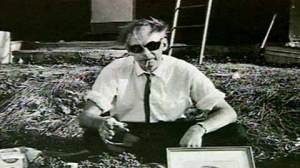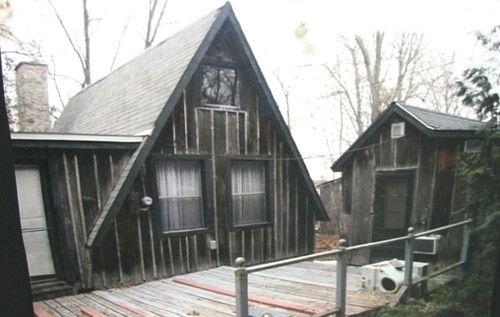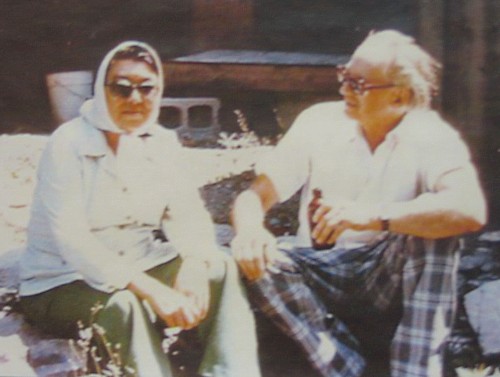 |
Poet Al Purdy built a cabin in Prince Edward County, Ont., where he composed some of his greatest work.
Dennis Robinson/The Globe and Mail
Contemporary poets seek to preserve iconic sanctuary of Canadian poetry
Jack Kerouac had his ’49 Hudson; Leonard Cohen had his tower of song; Al Purdy had his humble A-frame cabin in Ameliasburgh, Ontario on the edge of Roblin Lake.
The poet George Bowering writes that Prince Edward County, in which Ameliasburgh is situated, reminded him of “certain half-abandoned farm valleys of eastern British Columbia.” Purdy’s A-frame, Bowering adds, is composed of “lots of inexpert finishings made up for by the sense of talent and energy, and honest usefulness.” Its charm, apparently, was also appreciated by Bowering’s wife Jean Baird, who described it over the phone as “a true cottage in the sense of old-time Canadian cottages, with the extra cups and saucers from your real house.” It was a project that entailed years of work, and Al called it “the house that was never finished.”
Today, 10 years after his death, this spirit continues in a campaign to preserve this heritage site, one that many argue is an irreplaceable artifact of Canada’s literary and cultural past. Lead by Baird and a number of other contemporary figures in Canadian literature, the program will foster new generations of poets through a writer-in-residence program, providing them with the same creative sanctuary that spurred Purdy’s leap into the Canadian literary canon almost five decades ago.
Some say that Al Purdy was an underdog, or that he was, at least, an ally of underdogs. Al Purdy was a vital voice from working class, anti-authoritarian, and anti-establishment Canada. Bowering writes, “While [Milton] Acorn has found the search for beauty consistent with the proletarian cause, Purdy has supplied the robust humour without which the prol [sic] would be unrecognized as the authentic Canadian item.” Purdy’s friend and poet Dennis Lee has been quoted as saying, “He broke with the old, colonial mode of poetry and recast our imagination, so that it seems perfectly rooted in the place we occupy. No one else in English-Canadian poetry had really done that.” It is difficult to resist mythologizing him as the quintessential Canadian poet, as many literary critics have done. A self-taught erudite with negligible formal education, he was among the many men who rode the rails to Vancouver during the Great Depression. Purdy also served in the Royal Canadian Air Force, where he wrote his first collection of poems, The Enchanted Echo – work that he retrospectively labeled “crap.” His best work was yet to come.
What began as an empty plot that the Purdys bought for $800 in the late fifties later became the place where Purdy’s creative work flourished. In the early years on the property, Purdy was indigent, foraging through dumps for food – he even admitted to eating roadkill. However, in the years following the construction of the A-frame, Purdy came to see increasing literary and financial success. An archived photo of Purdy from the University of Saskatchewan library shows the writer doing yard work, wearing sunglasses and a plaid shirt rolled above his elbows – apparently, the same way that he read his poems in front of university audiences.
While he was building the house by Roblin Lake, Purdy also immersed himself in Canadian history and began to research Owen Roblin, grandson of a United Empire Loyalist and founder of “Roblin’s Mills” in Ameliasburgh. Purdy had deep roots in the loyalist bastions of Ontario: he himself was the descendant of loyalists and was born in Wooler, Ontario, a settlement near Kingston that has, by now, nearly disappeared. Baird claims that Purdy’s work on the house and his inquiries into the community surrounding Roblin Lake changed him from a “failure of a man” into a prolific poet.
Beyond its importance as Purdy’s artistic retreat, the A-frame famously nourished rising talent in Canadian poetry, a role that Baird and her collaborators hope to re-ignite. Purdy was a notorious host to dozens of guests, including Canadian literary A-listers like Margaret Atwood, Earle Birney, Margaret Laurence, and then-unknown Michael Ondaatje. Despite his open-armed hospitality, Purdy avoided coteries with other writers. Writing to his wife from Ameliasburgh on Milton Acorn, in a letter dated 1969, he writes, “Acorn is not like other acorns, he does not lie still on the forest floor and shut his big yap… [he] stalks thru the house reciting poems, all of which sound like the King James version…. I expect pity by return mail.” When I spoke to Baird, she said, laughing, that Purdy could be a “grump.” Despite this, he was indiscriminate with his houseguests, welcoming both renowned authors and virtual unknowns. On the Montreal poet Bryan McCarthy’s eight-day visit to the A-frame, Purdy wrote in 1966, “We spent two days consuming beer and the rest yak-yak, which consisted of 18-20 single-spaced pages of question and answer by the time he finished.” After Purdy’s death in 2000, the house continues to be visited in what Baird called “the Canadian poetry pilgrimage.”
To maintain this emblem of Canadian poetic achievement, Baird and Howard White, Purdy’s publisher, have attempted to preserve the house by founding the A-frame Trust. Poets David Helwig, Steven Heighton, Karen Solie, and Rob Budde have also designed the writer-in-residence program, in which chosen writers will receive a $2,500 monthly stipend to write while living in Purdy’s former abode. The A-frame Trust is an attempt to raise money to buy the house, make renovations, and establish funds for a writer’s endowment – a project that will cost $900,000 to carry through. If this writer-in-residence project succeeds, it will be one of only a few similar projects that exist in Canada, alongside the Kogawa House and the Haig-Brown House in British Columbia and the Berton House in the Yukon.
Purdy continues to be a name that is oft repeated and resonant in discussions about Canadian literature – but his legacy, hopefully, will live on as a “small whisper” in the woods near Roblin Lake.
Laurin Liu. Published on March. (http://www.mcgilldaily.com/2010/03/the_house_that_al_built/)
Al Purdy’s HouseAmeliasburgh, ON  Known as one of Canada’s most important poets, Purdy’s pretty A-frame on Roblin Lake was constructed out of second-hand lumber and became the most famous writer’s house in the country.  Al Purdy (1918-2000)
(...) Purdy lived in what amounts to a cabin in the woods, that he built himself, which means a great deal of the poetry which eventually won him the Order of Canada, the Order of Ontario, & the Governor General’s Award was written in a rough & ready A-frame near Kingston, Ontario (...) Palmerstonboulevard
 Al Purdy A-frame House Guest For two months we quarrelled over socialism …. poetry …. how to boil water doing the dishes …. carpentry …. Russian steel production figures and whether you could believe them and whether Toronto Leafs would take it all that year and maybe hockey was rather like a good jazz combo never knowing what came next Listening how the new house built with salvaged old lumber bent a little in the wind and dreamt of the trees it came from the time it was traveling thru and the world of snow moving all night in its blowing sleep while we discussed ultimate responsibility for a pile of dirty dishes Jews in the Negev …. the Bible as mythic literature …. Peking Man and in early morning looking outside to see the pink shapes of wind printed on snow and a red sun tumbling upward almost touching the house and fretwork tracks of rabbits outside where the window light had lain last night an audience watching in wonderment the odd human argument that uses words instead of teeth and got bored and went away Of course there was wild grape wine and a stove full of Douglas fir (railway salvage) and lake ice cracking its knuckles in hard Ontario weather and working with saw and hammer at the house all winter afternoon disagreeing about how to pound nails arguing vehemently over how to make good coffee Marcus Aurelius …. Spartacus …. Plato and François Villon And it used to frustrate him terribly that even when I was wrong he couldn’t prove it and when I agreed with him he was always suspicious and thought he must be wrong because I said he was right Every night the house shook from his snoring a great motor driving us on into daylight and the vibration was terrible Every morning I’d get up and say “Look at the nails- you snored them out half an inch in the night-” He’d believe me at first and look and get mad and glare and stare angrily out the window while I watched 10 minutes of irritation drain from his eyes onto fields and farms and miles and miles of snow We quarreled over how dour I was in early morning and how cheerful he was for counterpoint and I argued that a million years of evolution from snarling apeman have to be traversed before noon and the desirability of murder in a case like his and whether the Etruscans were really Semites the Celtic invasion of Britain …. European languages …. Roman law we argued about white being white (prove it dammit) …. & cockroaches bedbugs in Montreal …. separatism …. Nietzsche …. Iroquois horsebreakers on the prairie death of the individual and the ultimate destiny of man and one night we quarreled over how to cook eggs In the morning driving to town we hardly spoke and water poured downhill outside all day for it was spring when we were gone with frogs mentioning lyrically Russian steel production figures on Roblin Lake which were almost nil I left him hitch hiking on #2 Highway to Montreal and I guess I was wrong about those eggs – Al Purdy
Al Purdy Cabin PEC
Canadian poet AL PURDY wrote most of his best work in a small, self-built A-frame cabin tucked along the shore of Roblin Lake in Prince Edward County. He called this little corner of Ontario's Prince Edward County his 'tangential backyard universe.'
When Purdy died in 2000, he was hailed as one of the greatest Canadian poets of the last century. He had written more than 40 books, won a trophy case of awards, circled the globe. In May, a larger-than-life bronze statue of him was erected in Toronto.
Despite the caviar receptions and gold accolades, he always returned to this jury-rigged little A-frame tacked to a low-slung, leaning bungalow. The whole edifice, he observed, 'bent a little in the wind and dreamt of the trees it came from.'
"On a green island in Ontario/
I learned about being human/
Built a house and found the woman/
and we shall be there forever/
building a house that is never finished.”
Eurithe Purdy, his widow who lives in Sidney BC, has put the house up for sale and is hoping that the group FRIENDS OF AL PURDY will save it as a writing retreat for budding Canadian authors.
Al Purdy and Margaret Laurence were close friends, discussing their writing in letters which were published as A FRIENDSHIP IN LETTERS.
The A-frame house, made out of second-hand lumber and original poetry, became the most famous writer's house in the country. Hundreds of writers found their way to Roblin Lake in Ameliasburg to visit the Purdys and talk about poetry and history while downing beer or wild grape wine. A lot of poetry and prose came out of that hard-to-find place.
The Dead Poet
Al Purdy
From: Beyond Remembering - The collected poems of Al Purdy. 2000.
I was altered in the placenta
by the dead brother before me who built a place in the womb knowing I was coming: he wrote words on the walls of flesh painting a woman inside a woman whispering a faint lullaby that sings in my blind heart still The others were lumberjacks backwoods wrestlers and farmers their women were meek and mild nothing of them survives but an image inside an image of a cookstove and the kettle boiling — how else explain myself to myself where does the song come from? Now on my wanderings: at the Alhambra's lyric dazzle where the Moors built stone poems a wan white face peering out — and the shadow in Plato's cave remembers the small dead one — at Samarkand in pale blue light the words came slowly from him — I recall the music of blood on the Street of the Silversmiths Sleep softly spirit of earth as the days and nights join hands when everything becomes one thing wait softly brother but do not expect it to happen that great whoop announcing resurrection expect only a small whisper of birds nesting and green things growing and a brief saying of them and know where the words came from
http://palmerstonboulevard.wordpress.com/2008/07/20/literary-house-3-al-purdy/
http://www.theglobeandmail.com/news/arts/books/article1755992.ece
http://www.mcgilldaily.com/2010/03/the_house_that_al_built/
http://www.library.utoronto.ca/canpoetry/purdy/index.htm http://www.flickr.com/photos/24505006@N06/3461854143/ |

Rehabilitar habilitar una esperanza posibilitar un lugar un encuentro habitar un espacio un tiempo abrir los ojos a media caña respirar oler cada mañana caminar por las nubes regar los cipreses coger un puñado de arena sembrar la tierra con el viento oler oler la vida quedarse inmóvil viendo pasar las nubes... MOLER LA VIDA.
El tema central de este Blog es LA FILOSOFÍA DE LA CABAÑA y/o EL REGRESO A LA NATURALEZA o sobre la construcción de un "paradiso perduto" y encontrar un lugar en él. La experiencia de la quietud silenciosa en la contemplación y la conexión entre el corazón y la tierra. La cabaña como objeto y método de pensamiento. Una cabaña para aprender a vivir de nuevo, y como ejemplo de que otras maneras de vivir son posibles sobre la tierra.


No hay comentarios:
Publicar un comentario